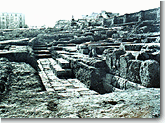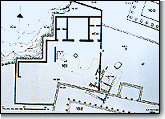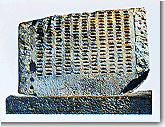


  |
|
|
|
  |
To the period of the reign of Demophon, too, is attributed the formation of the body of the ephetai, though they are first mentioned in the laws of Dracon. There were fifty-one ephetai, but it is not clear if they were simultaneously members of the Areopagus or were a completely different body. Their competence included certain cases of killing not tried by the Areopagus. Depending on circumstances they would meet in a different place. For trials of involuntary killing, attempted killing, and killing of a metic, foreigner, or slave, they would meet in the Palladium at Phalerum. In cases where the doer of the deed maintained that it had been a just killing (dikaios phonos), they would meet in the temple of Apollo Delphinius. Anyone who, while already in exile for some other killing, faced a new charge of killing, was tried at Phreattys. The ephetai would stand on the shore and the accused in a boat, so as not to pollute the city. Lastly, cases against inanimate objects that had caused somebody's death, or cases where in general the doer of the deed was unknown, were tried in the Prytaneum. The trying of cases of this kind was within the competence not of the ephetai but of the prytaneis (Aristotle, Athenaion Politeia 57.3-4). |
|
  |
At the start of the 6th century, one of the reforms put into practice by Solon was the formation of the Eliaia, the first People's Court. All citizens over the age of thirty could attend this if they showed their willingness to take part by having their names recorded on the relevant tablets. They were chosen by lot, and a special machinery, the cleroterium, was used for this purpose. In the Classical period it was to the Eliaia - which at that time was, in some scholars' view, simply a juridical accompaniment of the Assembly of the demos - that competence passed for trying all crimes that had previously been referred to the Areopagus and the archons. The Council of Five Hundred founded by Cleisthenes also had certain judicial powers in cases of wounding with intent to inflict death (traumata ek pronoias). To the Council, too, belonged control of all Athenian archons, the only exception being the generals, who were exclusively controlled by the Eliaia. |
Also with juridical competence in certain cases was a body with policing duties, the Eleven. The Eleven were appointed by lot. Besides overseeing the prison, its prisoners, and the carrying out of death sentences, they could try certain criminals caught in the act. Such cases were those of thieves, slave traders attempting to sell free men as slaves (andrapodistai), 'rififi men' (toichorychoi), and 'cutpurses' (balantiotomoi). The Eleven exercised their judicial rights in two ways: either di' apagoges (by citizen arrest) or di' ephegeseos (by laying an information). In the first case, they haled the accused, the man caught in the act, before them; in the second they themselves went to the scene of the crime and arrested him (Aristotle, Athenaion Politeia 52.1). Besides the city's law courts and juridical institutions, there were also local jurymen for the resolution of minor differences, in the demes or tribes. Pisistratus introduced the law court of the Forty. Here the jurymen were from all the tribes but were chosen by lot to judge cases in tribes other than their own: this at least is what Demosthenes says about the Oineis and the Erechthieis. Lastly, there were the diaitetai, including in theory all Athenians over the age of sixty. |
|
| |
|
Note: Click on a picture for a brief description. | |